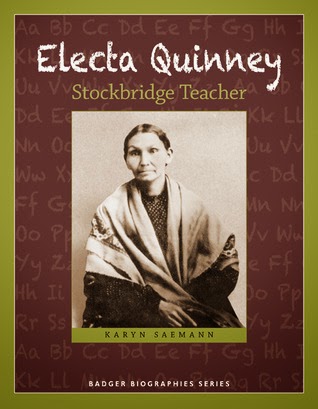Author: Karyn Saemann
Publisher: Wisconsin Historical Society Press
Pages: 112
Availability: First published March 4, 2014
Review Copy: Publisher
Summary: Electa Quinney loved to learn. Growing up in the early 1800s in New York, she went to some of the best boarding schools. There she learned how to read, write, and solve tough math problems—she even learned how to do needlework. Electa decided early on that she wanted to become a teacher so she could pass her knowledge on to others. But life wasn’t simple. Electa was a Stockbridge Indian, and her tribe was being pressured by the government and white settlers to move out of the state. So in 1828, Electa and others in her tribe moved to Wisconsin. Almost as soon as she arrived, Electa got to work again, teaching in a log building that also served as the local church. In that small school in the woods, Electa became Wisconsin’s very first public school teacher, educating the children of Stockbridge-Munsee Band of the Mohican Indians as well as the sons and daughters of nearby white settlers and missionaries. Electa’s life provides a detailed window onto pioneer Wisconsin and discusses the challenges and issues faced by American Indians in the nineteenth century. Through it all, Electa’s love of learning stands out, and her legacy as Wisconsin’s first public school teacher makes her an inspiration to students of today. -- Cover image and summary via Goodreads
Review: Last summer I attended the American Indian Studies Institute and while I was there found out that the Wisconsin Historical Society was planning to publish this biography. Since I was able to visit the museum on the Mohican reservation and learn a little about Electa Quinney, I was eager to finally read the finished product. This is a great addition to the Badger Biographies series. I appreciate that the people chosen for the series are from so many different walks of life and there is a fairly even mix of male and females.
Though this may appear to be a book written only for Wisconsin readers, Electa was born in New York and the book traces the path she took to Wisconsin and then to Indian Territory and back again so it covers a lot of ground. Saemann explains the reasons for the movement of the Mohican Nation and the includes history of other nations as they were forcibly moved into the Indian Territory too. This book would be a great overview of American Indian history regardless of a reader's geographical location.
Another positive aspect of the book is how the author explains that, "Understanding Electa's life is like working on a jigsaw puzzle." This is a great analogy. The research that was done for the book helped to uncover some of the details of her life, but much is missing. Saemann fills in some of the missing pieces with possibilities, but lets the reader know when there are holes. I think students will benefit from knowing that we can't always "google" something and know all of the answers. Sometimes in history there are gaps that may never be filled.
Like the other books in this series, the layout of the book is much like a textbook. There are many photos and other images scattered throughout and the text has a sufficient amount of white space around it so that young readers won't be overwhelmed. There are also many words in bold text that include definitions at the bottom of the page.
Electa's childhood is explained in addition to her positive boarding school experience at a Quaker school. Included with this is a history of the Stockbridge tribe and its move to Wisconsin. Readers will find that the Stockbridge families were living in houses made of logs with barns and farms. Once Electa moved to Indian Territory, we also find out about the first Indian newspaper in the United States - The Cherokee Phoenix which was a bilingual paper. Details of this kind have the potential to challenge beliefs that readers may have about American Indians.
Electa Quinney seems to have been a woman who valued learning and teaching and I am glad we have this record of her life. More than that though, I am happy to see the broader history of the Mohican and Cherokee Nations that the book encompasses. This will be an excellent addition to libraries throughout Wisconsin and beyond. I am eager to share it with my staff and students.

No comments:
Post a Comment